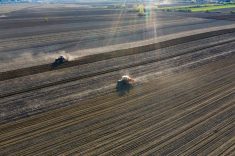Q: Can we fix compaction?
A: As equipment becomes bigger and total loaded weight becomes heavier, our soils are often subjected to compaction. When equipment was lighter, this compaction tended not to extend very deep into the soil, and the effect was often resolved by frost cycles that fractured and turned the surface soil. Now, compaction often extends to the subsoil and leads to multiple years of soil damage. Compaction from wheel tracks is often visible two or three years later.
Compacted soil limits root growth and can lead to limited water and nutrient uptake. The compacted layer will also limit water drainage, causing plants to suffer from both more flooding and then reduced water uptake. Compacted soil also has less ability to exchange soil air, and roots suffer from both air movement and disease infection. The many effects of compaction can cause a productive soil to lose long- term quality and lower yields for many years. Efforts to run implements through wet areas can lead to even more flooding in the future as sub- surface drainage is limited.
Read Also

Claas brings 1000 Series SP forage harvesters to Canada
In mid-August, Claas unveiled its new line of Jaguar forage harvesters at an event in Visalia, California, deep in the heart of that state’s dairy region.
Wheel damage can occur from any equipment — combines and grain carts in the fall may cause deep compaction, while tractors and sprayers cause both deep compaction plus smearing of the soil if wheels begin to spin. Even tillage implements that press down on soil can cause significant soil compaction.
Can we fix compaction? It is not easy, and the best choice is to avoid the problem. Deep, compacted layers are very difficult to alleviate. Shallow tillage or harrowing to “dry soils” is never a good solution — it always makes the problem worse. Deep tillage rarely can help, partly because it needs to be done when it’s dry to fracture the soil. Crops with taproots such as alfalfa or sweet clover may penetrate the layer, but annual species are not effective for deep layers of compaction. Subsurface tile drainage can provide a long-term solution, though this is expensive and is difficult to execute in low-lying or clay soils that are most often affected by compaction.
We will continue to be faced with compaction issues in the future, and these can severely reduce crop yield. Like so many cases in agronomy, there are no simple solutions to fix the problem, but being aware of the risk is important to help avoid the problem.
– Lyle Cowell, PAg, CCA, is the manager of agronomy solutions in northeast Saskatchewan for Nutrien Ag Solutions.














